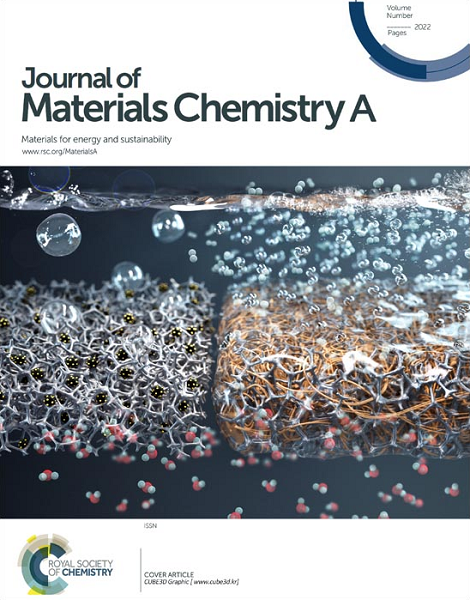通过在环氧化天然橡胶和聚苯胺之间构建 Fe3+ 异齿配位实现可回收的微孔橡胶泡沫和卓越的光热性能
IF 10.7
2区 材料科学
Q1 CHEMISTRY, PHYSICAL
引用次数: 0
摘要
开发具有优异光热转换能力的可回收微孔橡胶泡沫,既能减少资源浪费,又能收集太阳能,从而同时缓解环境污染和能源危机。在这项工作中,我们提出了一种新颖的 "一石二鸟 "策略:通过傅立叶变换红外光谱(FT-IR)、XPS和拉曼光谱(Raman)成功证实了环氧化天然橡胶与聚苯胺之间的Fe3+异配位结构。通过超临界二氧化碳发泡技术,首次制备并再加工了具有优异光热转换性能的可回收微孔环氧化天然橡胶/聚苯胺/FeCl3泡沫(f-EPx)。改变温度和氯化铁含量可控制粘弹性,进而调节细胞大小(4.4-9.0 μm)和泡沫拉伸性能(断裂伸长率高达 710%)。通过 "切割-成型-发泡 "循环实现了 f-EPx 的再循环。经过 4 次加工后,第 4 次再加工的 f-EPx 仍具有完整的细胞结构,断裂伸长率达到 400%。值得注意的是,Fe3+异齿配位赋予了 f-EPx 92.6% 的光热转换效率和 90.5% 的光触发形状记忆效应形状恢复率。令人惊奇的是,用 f-EPx 薄膜包裹的鸟蛋在近红外光下仅需 15 分钟就能完全煮熟,显示了其作为光热套管在太阳能收集领域的潜在应用。这项工作为制造可回收的微孔橡胶泡沫用于清洁能源利用提供了一种创新策略,为橡胶工业的可持续发展提供了设想。本文章由计算机程序翻译,如有差异,请以英文原文为准。
Recyclable microcellular rubber foams and superior photothermal performance via constructing Fe3+ heterodentate coordination between epoxidized natural rubber and polyaniline
Developing recyclable microcellular rubber foams with excellent photothermal conversion ability can reduce resource waste and harvest solar energy to alleviate the environmental pollution and energy crisis simultaneously. In this work, we propose a novel “one-stone-two-birds” strategy: the constructure of Fe3+ heterodentate coordination between epoxidized natural rubber and polyaniline were successfully confirmed by FT-IR, XPS, and Raman. Through supercritical CO2 foaming technology, recyclable microcellular epoxidized natural rubber/polyaniline/FeCl3 foams (f-EPx) with excellent photothermal conversion were first fabricated and reprocessed. Changing the temperature and FeCl3 content could control the viscoelasticity, subsequently regulating cell size (4.4-9.0 μm) and foam tensile properties (elongation at break up to 710%). The recycling of f-EPx was realized through “cutting-molding-foaming” cycles. After 4 cycles of processing, the 4th reprocessed f-EPx still possessed intact cell structure with 400% elongation at break. Remarkably, Fe3+ heterodentate coordination endowed f-EPx to harvest 92.6% photothermal conversion efficiency and 90.5% shape recovery ratio by photo-triggered shape memory effects. Strikingly, the bird egg wrapped by f-EPx film could be cooked thoroughly under near-infrared light for only 15 minutes, exhibiting potential applications as photo-heating sleeves in solar energy harvesting. This work provides an innovative strategy to fabricating recyclable microcellular rubber foams for clean energy utilization, envisioning the sustainable development of rubber industry.
求助全文
通过发布文献求助,成功后即可免费获取论文全文。
去求助
来源期刊

Journal of Materials Chemistry A
CHEMISTRY, PHYSICAL-ENERGY & FUELS
CiteScore
19.50
自引率
5.00%
发文量
1892
审稿时长
1.5 months
期刊介绍:
The Journal of Materials Chemistry A, B & C covers a wide range of high-quality studies in the field of materials chemistry, with each section focusing on specific applications of the materials studied. Journal of Materials Chemistry A emphasizes applications in energy and sustainability, including topics such as artificial photosynthesis, batteries, and fuel cells. Journal of Materials Chemistry B focuses on applications in biology and medicine, while Journal of Materials Chemistry C covers applications in optical, magnetic, and electronic devices. Example topic areas within the scope of Journal of Materials Chemistry A include catalysis, green/sustainable materials, sensors, and water treatment, among others.
 求助内容:
求助内容: 应助结果提醒方式:
应助结果提醒方式:


